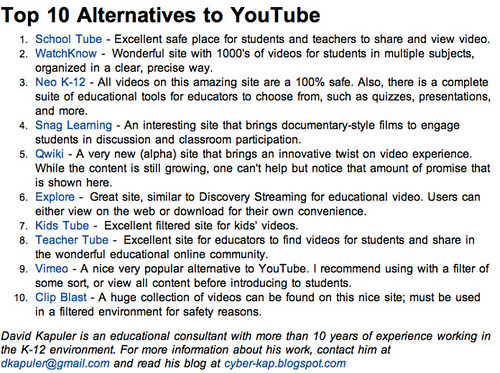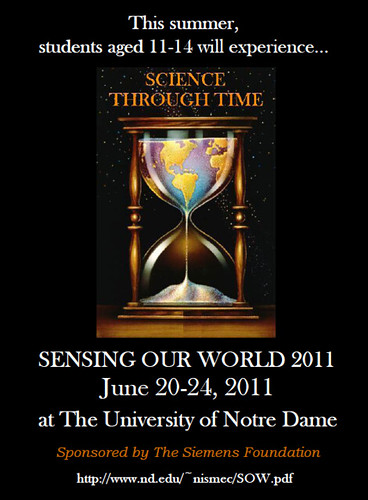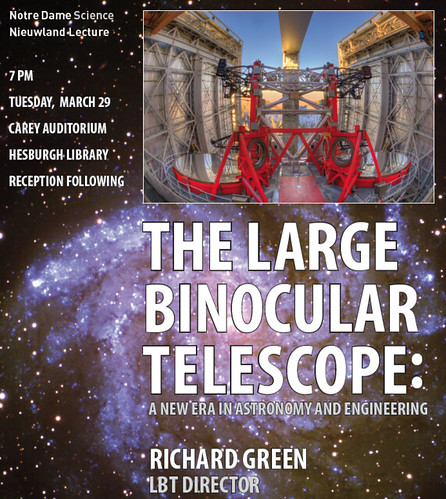We quite often hear that YouTube is blocked in K-12 classrooms. Just click on the image above to read this blog post about ten free alternatives to YouTube. ~
Author Archives: Thomas
Teaching Well Using Technology
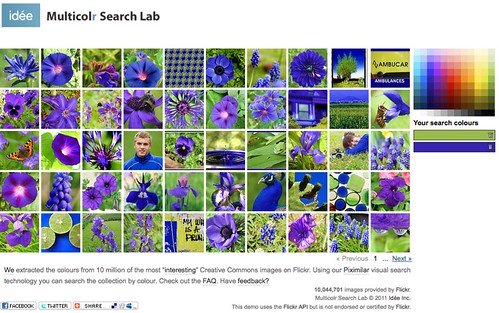
How can you not like this tool? It’s one of my favorites from a workshop offered by the Kaneb Center: Teaching Well Using Technology . Jamie Antonelli and I attended the workshop today. Perhaps unlike my favorite tool linked above, many of the tools and tips we received were quite useful.
The workshop uses a wikispace site, on which Jamie and I created a project page, advancing a project (also hosted on a wiki) begun last year.
Without any pretense of coherence, below is a list of highlights from the workshop.
One very interesting tool to which I”ve just now been introduced is EtherPag (or in this case, a free version called TitanPad. This tool allows anyone to set up a “backchannel” during a workshop…something like a chat room where notes can be gathered and responded to as the workshop advances. Everyone can type into it at the same time. Lots of online presentations use a backchannel of this sort, and I find them helpful. But this is the first time I’d run across a free version which can be integrated into almost any other technology (such as a wiki home page for the workshop.) If I had just employed the correct rule of thumb–“if you can think of it, it exists online, and is free”–I’d have found it earlier:)
Another new tool for me is grooveshark (mentioned only incidentally in the workshop, but of great interest to me.) Grooveshark enables you to share music, even in a widget; my first experiment with it is here.
Jamie Antonelli found the “insert invisible frame” solution to navigating through a single slide in Prezi. (I’ll hyperlink his solution from here when I gain access to it.)
McKeechie’s Teaching Tips was recommended as a great useful text for folks teaching in higher ed.
Here’s a Google slideshow illustrating 66 ways to use Google Forms in a classroom context.
More resources used and/or recommended in the workshop can be found here. Enjoy.
Step-wise implementation of TOW, while thinking through our social media strategy
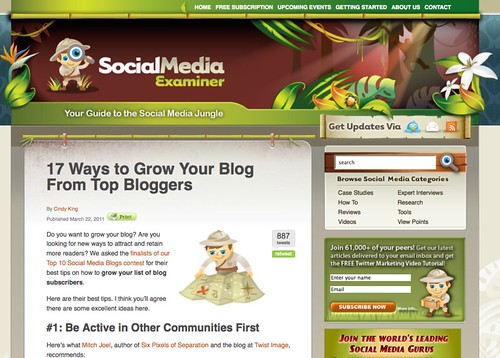
At yesterday’s meeting we introduced and set up a “topic of the week” (TOW) strategy for adding interesting content to our blogs. I’m proposing that we try that strategy here, “in public” but not “to the public”, in our management blog, prior to rolling it out to our delicate shoot of new subscribers (137 as of this posting.) I’d like to propose that at the same time we take a little time to see what strategies successful social media strategists recommend. If we like what we produce in the “topic of the week” series after two or three weeks, we can then advance the series as a whole, or perhaps just a few blogs at a time, to the MichianaSTEM Community blog. So, Val, would you kick off the weekly topical discussion here in the management blog? I think this is a very good idea and I want to help make it work. There is some risk that keeping it to ourselves at first may quench enthusiasm. Let’s try not to let that happen. If it’s a workable idea, we should be able to push it into existence here, first, and then into a broader stream. I’m no expert, but I think that’s a sensible approach to managing our public profile.
Please click on the image above to visit a site with an interesting compilation of suggestions for effective blogging. I think that the very first suggestion is one we should talk about in particular; we don’t interact very much with other environments. The GK-12 blog might help change that, but we should explore other avenues, also. Additional recommendations in this list of 17 suggestions might help us think through our own approach to blogging.
One way to encourage interactions with other blogs is through a blogroll, where links to other community sites are right at hand for everyone who interacts with our blogs. Perhaps each of us could add one blog to the blogroll (accessible under the links tab in the management interface) 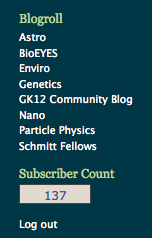 from our areas of interest and/or expertise. For a model, see the blogroll (though thee are all internal sites, and what we need are external sites) for the MichianaSTEM blog.
from our areas of interest and/or expertise. For a model, see the blogroll (though thee are all internal sites, and what we need are external sites) for the MichianaSTEM blog.
Science at Swanson Primary Center
Swanson Primary Center, like some 70 other Michiana K-12 schools, has been an active collaborator in Michiana STEM education. At least five teachers from Swanson have attended NDeRC events. This year, Swanson has hosted two programs that bring scientists into classrooms–NANO (above) and BioEYES (below). Moreover, they have put together some very nice online presentations. Kudos to this South Bend Community School Corporation school for their efforts to reach out to university partners.
A few moments of raptor bliss…
Who wouldn’t want a few moments watching nesting eagles, live? Join several thousand other folks, just for fun. (Click on the lower “play” button if you want to watch the embedded version here; clicking the main screen will redirect you to the host page at Ustream.) To see more, visit the raptor resource web site.
Brainstorming in DC
Ten members of the Notre Dame extended Research Community are heading to DC this weekend for the GK-12 annual meeting. These meetings are extraordinarily rich times for reviewing what others are doing in university/K-12 relations across the country. This year’s event will be marked by some controversy, since the NSF has announced that GK-12 will be phased out, with no new programs being accepted. This year’s NDeRC contingent–two university faculty, two K-12 teachers, and six graduate students–will be looking for ways to add value to our integrated STEM community here in Michiana, and will share with other GK-12 programs some of what we’ve been busy doing here. Embedded above are slides from last year’s trip. Watch for reports next week!
Invitation to GLOBE at Night collaboration
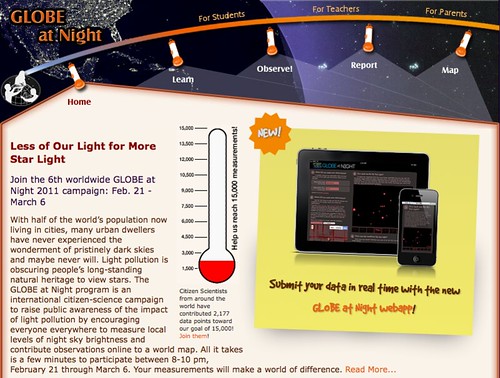
I’m passing along the invitation below from Connie Walker of the National Optical Astronomy Observatory (NOAO). This concern for light pollution is an important project of our friend and regional collaborator Chuck Bueter of Nightwise.org. So anyone interested in this GLOBE activity might contact Chuck:)
Less of Our Light for More Star Light
Join the 6th annual worldwide GLOBE at Night 2011 campaign: Feb. 21 – March 6
What: The Globe at Night Campaign
When: 8pm to 10pm local time, February 21 – March 6, 2011
Where: Everywhere
Who: Everyone
How: See http://www.globeatnight.org
GLOBE at Night encourages citizen-scientists worldwide to record the brightness of the night sky. During 2 winter/spring weeks of moonless evenings, children and adults match the appearance of a constellation (Orion in February/March and Leo and Crux in March/April) with 7 star charts of progressively fainter stars found at www.globeatnight.org. They then submit their choice of star chart on-line with their date, time and location to help create a light pollution map worldwide.
The GLOBE at Night 2011 campaign dates are February 21 – March 6 (worldwide) and March 22 – April 4 (for the Northern Hemisphere) and March 24 – April 6 (for the Southern Hemisphere). 52,000 measurements have been contributed from more than 100 countries over the last 5 years of two-week campaigns, thanks to everyone who participated!
This year children and adults can submit their measurements in real time if they have a smart phone or tablet. To do this, you can use the web application at www.globeatnight.org/webapp/. With smart phones and tablets, the location, date and time are put in automatically. And if you do not have a smart phone or tablet, there are user-friendly tools on the GLOBE at Night report page to find latitude and longitude.
Through GLOBE at Night, students, teachers, parents and community members are amassing a data set from which they can explore the nature of light pollution locally and across the globe. Please make a difference and join our efforts in 2011. For activity packets, one-page flyers and postcards advertising the campaign, visit www.globeatnight.org/pdf/.
~~~~~~~~~~~~~~~~~~~~
Constance E. Walker, Ph.D.
director, GLOBE at Night campaign (www.globeatnight.org)
chair, International Dark-Sky Association Education Committee
chair, IYA2009 Dark Skies Awareness Cornerstone Project
member, Astronomical Society of the Pacific Board of Directors
associate scientist & senior science education specialist, NOAO
National Optical Astronomy Observatory (NOAO)
950 N. Cherry Avenue
Tucson, AZ 85719 USA
520-318-8535
cwalker AT noao.edu
Summer science workshop for middle schoolers: Sensing Our World
Below I pass along an announcement for a very cool week-long summer science program at Notre Dame for middle school students. NDeRC’s Enviro collaboration organized a day-long session in this event last year, and we had a blast. Send this announcement along to middle school students and their parents, cementing your friendship with them for life:)
This year’s Sensing Our World: Science Through Time program will explore themes from Earth’s past, present, and future in biology, physics, chemistry, mathematics, and geology. Scientific processes occuron time scales from nanoseconds to eons. In the blink of an eye, cells can divide and a hummingbird can flap its wings almost 90 times! At much lengthier time scales, continents move and animals go extinct, like the dinosaurs. Scientists often look to the past to understand the world today. Also, by understanding current processes and trends, they make predictions about the future.
The week will involve hands-on science, including exploring the structure of skeletons at the Museum of Biodiversity, immersing ourselves in nature to understand the complexities of ecosystems, and tackling issues related to climate change –such as, what should we do for polar bears if all the sea ice melts? We hope you’ll join professors and graduate students during this exciting week on the campus of Notre Dame, so complete the application today!
Classes will be held at the Notre Dame campus Monday through Friday, from 9:00 a.m. to 4:00 p.m. Activities include meeting with ND scientists to learn about their research, and visits to several different academic departments and research labs on campus. We expect a large response to the summer program, so please read through the instructions carefully. The deadline for applications is May 13, 2011. Applications are reviewed by a selection committee, and students will be admitted to the week’s hands-on science exploration program. Selection notices will be e-mailed to students by June 1, 2011.
SPONSORS
Sensing Our World 2011: Science Through Time is supported and sponsored by
•The Siemens Foundation
•The Northern Indiana Science, Mathematics, and Engineering Consortium (NISMEC)
•The Joint Institute for Astrophysics (JINA) and the Nuclear Structure Laboratory
•The Department of Biological Sciences
•The Department of Physics
•The College of Science
March 29 public lecture: The Large Binocular Telescope
This public lecture is a chance to get a very close look into a major scientific instrument and the experiments surrounding it: the Large Binocular Telescope. I’d recommend it for anyone interested in science and engineering. The lecture might be a stretch for middle school students, but just the right kind of stretch. K-12 science teachers are especially encouraged to attend. Mark your calendars for 7:00 PM, Tuesday, March 29.
I’ve seen the LBT mirrors being ground under the University of Arizona football stadium…each of them is about as large as your living room and kitchen, combined. Come and see. If you’ve got five minutes to peer into the infrastructure of mirror creation, watch the video below:)
The University of Notre Dame is one of nine LBT Corporation Partners.
From the event announcement:
“The Large Binocular Telescope is a marvel of precision engineering with massive scale. With its two 8.4 meter (27.6 foot) diameter primary mirrors on a common mount, it is the largest optical telescope in the world. The primary mirrors are actively controlled at a slow rate to maintain their perfect figures, while the secondary mirrors change shape 1000 times a second to compensate for the blur of the atmosphere. The instrument complement includes pairs of optimized 36 megapixel CCD cameras, high-throughput optical spectographs, and unique multi-object infrared spectographs. Two additional instruments will combine the light coherently from the two sides to create images ten times sharper than those from Hubble Space Telescope. Scientific discovery has been underway since 2008 in fields ranging from stellar archaeology in nearby galaxies to star formation in the distant universe. Notre Dame astronomers have played a leading role as scientific investigators with this unique facility.”
DNA replication in cells, laboratories and schools
As the Cloning a Fluorescent Gene lab returns to Saint Joseph’s High School for a second week, this video provides an occasion for marveling at the DNA copying process both in the cellular context (represented in the video above) as well as in the Polymerase Chain Reaction (PCR) process (below.) Enjoy!
